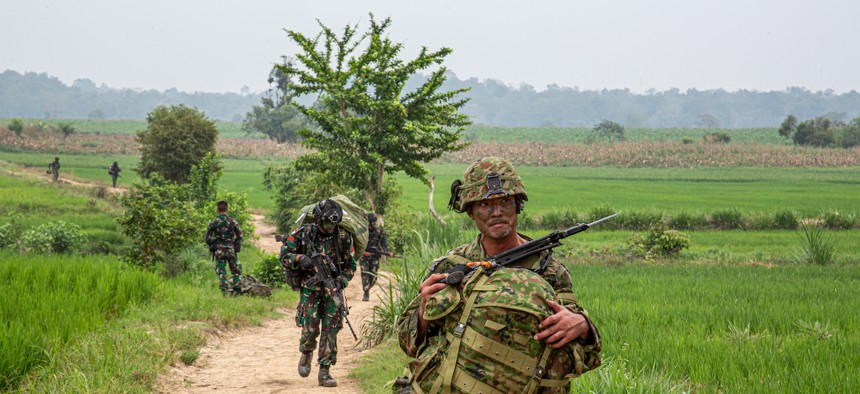
Paratroopers with 1st Special Forces Group (Airborne), Japan Ground Self-Defense Force, Indonesia National Armed Forces, and 2-11 Infantry Regiment conduct a multinational airborne operation to kick off Super Garuda Shield 22 in Baturaja, Indonesia, on Aug. 3, 2022. U.S. Army / Staff Sgt. Matthew Crane
America's Pacific allies want more joint exercises, short-supply munitions
China’s neighbors are learning from the Ukraine war—including the value of long-range fires.
FORT SHAFTER, Hawaii—U.S. allies in the Pacific are asking for more multinational exercises—and more of the short-supply munitions that have helped Ukraine fight off Russia.
“Frankly, our allies and partners are watching very closely what's happening in Ukraine. They’re very interested in how they preserve their territorial integrity,” Army Brig. Gen. James Bartholomees, chief of staff to United States Army Pacific, or USAPAC, told Defense One during an interview in Hawaii.
Australia and Taiwan are slated to get HIMARS rocket launchers. But there are other ways the United States can get the weapon to regional partners.
The U.S. military has been conducting live-fire exercises with the Philippines, Japan, Australia, and other countries in the region recently.
“All of those are synchronized with the ally or partner and their equivalent capability so that we can conduct rehearsals of how we would employ those fires. So from a HIMARS perspective, yes…high demand,” Bartholomees said.
But all of that demand could strain the supply of HIMARS artillery, particularly given the intense need for those munitions in Ukraine. And 155-millimeter howitzer shells are also in demand in the Indo-Pacific.
“We are actually seeing some demand there. And that munition challenge with 155s, it's significant,” he said. India's armed forces in particular are pressing for more deliveries.
The Army’s Multi-Domain Task Force, or MDTF, teams, have a long-range fires battalion. In May, one of the MDTF teams completed an exercise with the Philippines. Next month, there’s a similar exercise in Indonesia—Super Garuda Shield—which will also include a long-range fires component, but not an MDTF team.
Said Bartholomees, exercises like Super Garuda Shield are growing in scope and complexity, at the request of the host countries who want to test how well they can operate as a joint service, but also with partner nations in the region for a unified front. That’s a big change from previous exercises, where militaries would look to more modest objectives.
Now, he said, “The conversation is more going to ‘Hey, how do we rehearse together if we were going to fight as a combined force? How would we exercise all of these capabilities?’”
Pacific nations may not want to permanently host a big U.S. long-range missile battery pointed at China, but they like having one around, Bartholomees said.
“We're finding there's a thirst for that, because they want the training that comes with it. And that's something we didn't really anticipate.”
U.S. Indo-Pacific Command is working to bring more domains and partners into its exercises. And they are quickly working up new digital interfaces, such as a new mission partner environment, to allow very different militaries to share data and work together quickly.
That doesn’t necessarily mean every nation in the Pacific is interested in providing a unified front to China in every possible scenario. And because there is no formal military alliance among them, it’s unclear which nations might come to the aid of Taiwan in the event of a Chinese invasion. But regional players like the Philippines are becoming more bold in discussing China, if not exactly as a threat, then at least the primary motivation for their desire to train with one another and train harder. “There's a much more overt discussion,” about that, Bartholomees said.
Even without a formal mutual defense treaty or alliance, regional players will play a key role in any potential conflict in the Pacific and in deterring one, he said.
The Chinese military has some key advantages when it comes to a Pacific fight: the overwhelming size of their military, the large number of rockets and fires they have (also known as magazine depth), and their internal logistics and resupply lines, Bartholomees said.
“We may not be able to counter the mass. We can through allies and partners so that needs to build over time. The magazine depth is an industrial issue that, obviously, all of our nations are fighting to get on top of. But interior lines are something that we can influence through campaigning forward, having forced his posture forward.”





